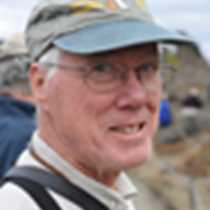Endicott Arm
From Holkham Bay two narrow fjords - Tracy Arm and Endicott Arm - slash deep into the mainland of Alaska, nearly into Canada. Many visitors consider them the most beautiful of the fjords of Southeast Alaska, and you would be hard pressed to find disagreement on the Sea Lion today. Tracy Arm is the better known and more frequently visited of the two, but finding it choked with ice calved from the Sawyer Glaciers, we chose the road less traveled and headed up Endicott Arm. There, during the ice ages, two glaciers collided and engaged in a shoving match that ended in a stalemate: neither glacier was able to advance. The result is a shallow passage - Ford’s Terror (ominous music plays in the background) that connects two deeper basins. As the tide ebbs and flows water rushes over this constriction with a rapid current, causing eddies and standing waves – just the place for a death-defying Zodiac ride (well, perhaps I exaggerate a bit.)
We retraced our path down Endicott Arm for a stop at the Dawes Glacier. This is one of Alaska’s many tidewater glaciers – that is, a glacier that ends in the ocean, calving ice into the associated fjord. Once more into our Zodiacs, we cruised as close to the glacier face as prudence would allow. Our departure was closely watched by the mountain goat seen above, somehow making a living among the Sitka alders on the impossibly steep slope. As we approached the glacier we stopped the engine to listen to the sounds of floating ice – the popping of air bubbles escaping from their long imprisonment in the ice, and the tinkling chime of myriad crystalline collisions. These air bubbles provide a sample of the atmosphere that existed when the snow fell and was transformed into ice, and thus they teach us about the earth’s history. Occasionally another, stronger sound echoed from the walls of the fjord – the sound of tons of ice calving from the face of the glacier into the sea with a roar and a mighty splash. This water was evaporated from the sea some hundreds of years ago; it was carried over the land by the Westerly winds, fell as snow, was buried by more snow and transformed by pressure into ice, and then flowed down the slope as a moving river of ice. Today, as we watched, it completed its journey and returned to the sea. And we, too, complete our journey as the Sea Lion heads for a quiet overnight anchorage in Holkham Bay and, early tomorrow morning, the short run to Juneau, Alaska’s capital city, and our return to civilization. We will be better for the knowledge that, after our departure, the glacier will still calve and that goat will still gaze out over the beauty of Alaska.
From Holkham Bay two narrow fjords - Tracy Arm and Endicott Arm - slash deep into the mainland of Alaska, nearly into Canada. Many visitors consider them the most beautiful of the fjords of Southeast Alaska, and you would be hard pressed to find disagreement on the Sea Lion today. Tracy Arm is the better known and more frequently visited of the two, but finding it choked with ice calved from the Sawyer Glaciers, we chose the road less traveled and headed up Endicott Arm. There, during the ice ages, two glaciers collided and engaged in a shoving match that ended in a stalemate: neither glacier was able to advance. The result is a shallow passage - Ford’s Terror (ominous music plays in the background) that connects two deeper basins. As the tide ebbs and flows water rushes over this constriction with a rapid current, causing eddies and standing waves – just the place for a death-defying Zodiac ride (well, perhaps I exaggerate a bit.)
We retraced our path down Endicott Arm for a stop at the Dawes Glacier. This is one of Alaska’s many tidewater glaciers – that is, a glacier that ends in the ocean, calving ice into the associated fjord. Once more into our Zodiacs, we cruised as close to the glacier face as prudence would allow. Our departure was closely watched by the mountain goat seen above, somehow making a living among the Sitka alders on the impossibly steep slope. As we approached the glacier we stopped the engine to listen to the sounds of floating ice – the popping of air bubbles escaping from their long imprisonment in the ice, and the tinkling chime of myriad crystalline collisions. These air bubbles provide a sample of the atmosphere that existed when the snow fell and was transformed into ice, and thus they teach us about the earth’s history. Occasionally another, stronger sound echoed from the walls of the fjord – the sound of tons of ice calving from the face of the glacier into the sea with a roar and a mighty splash. This water was evaporated from the sea some hundreds of years ago; it was carried over the land by the Westerly winds, fell as snow, was buried by more snow and transformed by pressure into ice, and then flowed down the slope as a moving river of ice. Today, as we watched, it completed its journey and returned to the sea. And we, too, complete our journey as the Sea Lion heads for a quiet overnight anchorage in Holkham Bay and, early tomorrow morning, the short run to Juneau, Alaska’s capital city, and our return to civilization. We will be better for the knowledge that, after our departure, the glacier will still calve and that goat will still gaze out over the beauty of Alaska.



